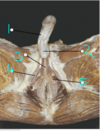Problems of the male reproductive system Flashcards
(53 cards)
Which two structures pass through the prostate? [2]
prostatic urethra [1]
ejaculatory ducts [1]
Which of the following is the seminal gland
A
B
C
D
E
F

Which of the following is the seminal gland
A
B
C
D
E
F
Describe / draw the structure of the prostate [4]
4 main areas (3 of which are glandular)
- Peripheral zone
- Central zone
- Transition zone
- Anterior fibromuscular zone

Which part of the prostate is outlined
- Peripheral zone
- Central zone
- Transition zone
- Anterior fibromuscular zone

Which part of the prostate is outlined
- Peripheral zone
- Central zone
- Transition zone
- Anterior fibromuscular zone
Which part of the prostate is outlined
- Peripheral zone
- Central zone
- Transition zone
- Anterior fibromuscular zone

Which part of the prostate is outlined
- Peripheral zone
- Central zone
- Transition zone
- Anterior fibromuscular zone
Which part of the prostate is outlined
- Peripheral zone
- Central zone
- Transition zone
- Anterior fibromuscular zone

Which part of the prostate is outlined
- Peripheral zone
- Central zone
- Transition zone
- Anterior fibromuscular zone
Which area of the prostate is made from fibromuscular stroma? [1]
Anterior fibromuscular stroma

Histology xx
When conducting a benign prostate enlargement (hyperplasia) exam, which part of the prostate are you feeling?
What would indicate this compared to prostate cancer?
Posterior zone
BPE is enlarged - but remains smooth (cancer causes hard hard and lumpy)

Why is BPE problematic? [1]
What is the main cause of BPE? [1]
Urethra becomes compressed: narrows it.
Increased tesosterone / other testicular androgens. Also caused by oestrogens

What is outlined by the arrow [1] and circle [1] on this histology of prostate?

Arrow: (interdigitating) skeletal muscle fibers
Circle: paired ejaculatory ducts
The [] zone is the area commonly affected in benign prostate enlargement.
The transitional zone is the area commonly affected in benign prostate enlargement.
Explain mechanism of proliferation versus apoptosis in normal prostate vs BPE
Testosterone is converted to oestradiol in the stromal cells via the enzyme aromatase.
oestradiol then goes to the enzyme oestrogen receptor alpha and drives cell proliferation after it binds to in the stromal cells.
Oestradiol also goes into the epithelial cells and activate oestrogen receptor beta of the glands (in both the basal and luminal epithelial cells) and causes apoptosis
Testosterone can also enter directly into the basal epithelial cells converted to Dihydrotestosterone (DHT) by 5-alpha reductase in the epithelial cells. DHT can then pass into luminal epithelial, binds to androgen receptor and stops apoptosis
With BPE most of the oestradoil goes to the stomal cells and ERa and causes proliferation. Very little goes to ERbeta to cause apoptosis.
Due to increased Testosterone and therefore DHT: get more of androgen receptor, which drives luminal cells to hypetrophy.
Get proliferation of stromal cells and hypertrophy of epitheilial cells

FYI
All men over 40 have this
50% will develop histological hyperplasia
50% of these with have lower urinary tract symptoms (LUTS)
Some will develop significant enlarged prostate (EP)
Some will develop bladder outlet obstruction (BOO)

What are symptoms of BPE? [5]
Symptoms
* Weak or interrupted flow of urine
* Frequent urination (nocturia)
* Trouble urinating
* Pain or burning during urination (urine gets stuck in bladder - causes infection)
* Blood in urine or semen
SHITE = Slow stream, Hesitancy, Intermittent flow, Terminal dribbling, Emptying is incomplete.

How do you diagnose BPE? [5]
- Hx
- Digital rectal exam
- Ultrasound - measure the size of the prostate (also check isnt cancer)
- Biospy
- Blood test (prostate speficic antigen - although not that specific for BPE)

How can you treat BPE? [6]
α1-adrenergic blockers
* Relaxes smooth muscle in bladder neck and prostate improving urine flow rate
5-α-reductase inhibitors
* 2 isoforms type I and type II (type II predominant prostatic reductase) blocks the formation of DHT.
Dutasteride
Finasteride
Combinations
Surgery
* Open prostatectomy (for very large prostates, >75g)
* UroLift
Laser ablation
Transurehral microwave
High energy ultrasound therapy

What do need to think about with regards to BPE and prostate cancer? [1]
How can you distinguish between the two? [1]
Symptoms of BHP may be similar to prostate cancer
PSA (if raised) tends to be much higher than in BPH
Describe the relationship of direct and indirect inguial hernias to inferior epigastric vessels [2]
Direct: medial to IPV
Indirecct: lateral to IPV

What are the borders of Hesselbachs triangle? [3]
Which type of inguinal hernias pass through Hesselbachs triangle? [1]
Medial – lateral border of the rectus abdominis muscle.
Lateral – inferior epigastric vessels.
Inferior – inguinal ligament.
Direct inguinal hernias pass through

Which side is more common to have indirect inguinal hernia in? [1]
Right = 80%
What causes indirect inguinal hernia? [1]
How do you treat? [1]
processus vaginalis doesnt close - means loop of intestine can fall into the scrotum
Treat with surgery
The inferior epigastric artery forms the lateral border of inguinal triangle. From which artery does it arise?
Inferior mesenteric
External pudendal
Common iliac
External iliac
The inferior epigastric artery forms the lateral border of inguinal triangle. From which artery does it arise?
Inferior mesenteric
External pudendal
Common iliac
External iliac
Which type of hernia occurs through Hesselbach’s triangle?
Direct inguinal
Incarcerated femoral
Paramedian
Deep inguinal
Which type of hernia occurs through Hesselbach’s triangle?
Direct inguinal
Incarcerated femoral
Paramedian
Deep inguinal



























